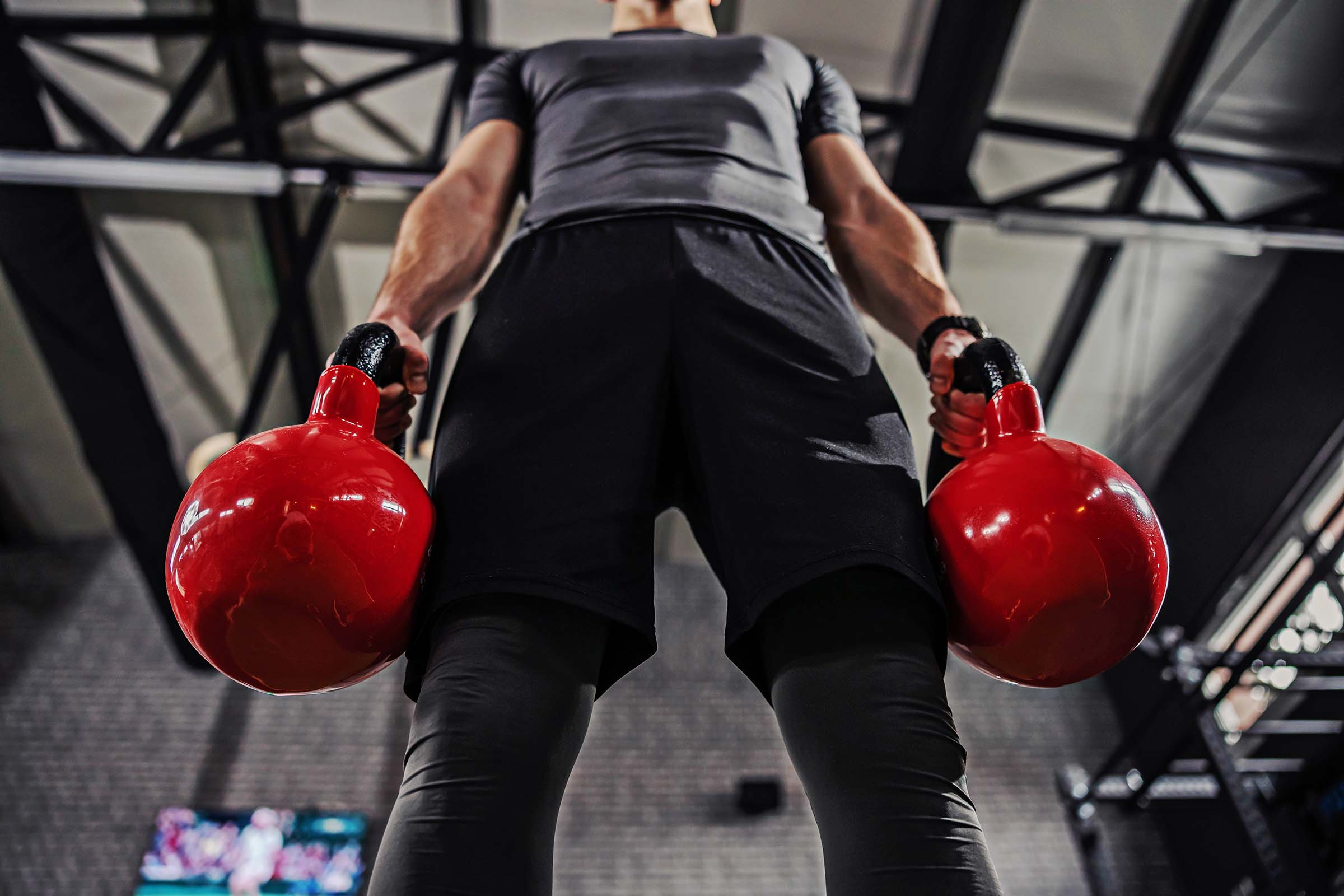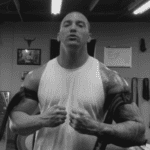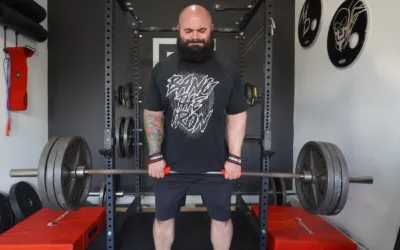Strongman Training for a Bigger, Beefier Back

Strongman workouts are focused on one thing: brute force. And what’s the hallmark of a body that looks like it can generate brute force? A massive back. If you’re trying to grow a wider back shield, you’d better be adding strongman work into your training.
Mike Richardson is an ISSA Tactical Conditioning Specialist, former Army 11B infantryman, and the creator of a Swole Town, popular performance hypertrophy programs. Take his advice in this blog and start working on two strongman lifts to grow a gorilla-sized back.
mike richardson

Every Day Is Back Day
- Give you bigger, thicker traps
- Improve other lifts like your deadlift, squat and bench press
- Help build a back that even silverback gorillas would envy
Your Back is Your “Shield”
But why do we call it that? For starters, a wide back is a status symbol of strength and power. When you see someone with huge traps, you just know they’re strong. I believe this is hardwired into our brains. You don’t get that look by accident, you get it through hard work.
Second, and most important, your back is your foundation for just about all other movements. In the bench press, your back provides stability, protecting the shoulders and allowing for a stronger base to press from. In the deadlift, your lats function isometrically, keeping your upper back neutral (not getting pulled forward) and keeping the bar close to your body.
Your entire back is the cornerstone of strength and stability under load, so it only makes sense to train it for maximum capacity. Working on the same old rows and pulldowns isn’t terrible, but it also isn’t optimal if you want to look like you can carry a truck.
The following strongman-style movements can dramatically strengthen your back and trunk, and pack slabs of muscle on your traps, neck, upper back, even your shoulders and arms.
Change the Way You Train
The Best Strongman Lifts for a Stronger Back
Farmer Carries
Farmer carries are a staple in my programming, and for good reason. They’re an incredibly underutilized and underrated movement you don’t see much of in commercial gyms. But we can change that!
How-To
To perform a farmer’s carry, you simply grab two heavy objects (dumbbells, kettlebells), or use a trap bar, and walk forward. The key points of performance are to stand tall, keep your chest up and shoulders back. Take small, calculated steps, walking forward and maintaining your posture at all times.
As you walk, your trunk must constantly account for small “micro” movements of the weight shifting to stabilize your spine and hold your posture as you move forward.
Your traps are being challenged isometrically, with the weight pulling down on them, holding tremendous tension for the duration of the movement, which can be a huge stimulus for hypertrophy (basically a loaded stretch).
If you really want to torch your traps, try hitting farmer carries followed immediately by shrugs.
Zercher Position Movements
Holding weight in the Zercher position is the epitome of trunk strength. As the weight tries to pull you forward, your back has to keep your torso stable. You can think of Zerchers as a standing, weighted plank position.
This upper back strength and stability directly translates to squats and deadlifts, as well as overhead pressing, bench pressing, and anything requiring stability through your trunk.
In short, zerchers are highly functional. I learned this one day last year when my 80lb dog, Harley, decided to give up on a long hike. I had to carry him in the zercher position for about a mile and it was brutally hard.
For tactical athletes in particular, carrying objects (and possibly injured teammates) across unknown distances and terrain can be a harsh reality. The real-world implications and functionality of this type of training can’t be ignored!
How-To
There are numerous movements that can be performed from the Zercher position. To get into position, place a barbell in the crook of your arms, letting it rest in your elbow meat, Cradle it on your torso with your chest up and shoulders back.
From this position, you can perform:
Zercher Squats
Fight to keep your torso upright with a slightly wider than normal stance, squatting your elbows between your legs. Check out our popular in-depth blog here — How to Zercher Squat: One Exercise to Rule Them All
Zercher Carries
With the barbell, yoke, or even a sandbag in the Zercher Position, walk forward, taking small, calculated steps and fighting to keep your trunk tight and upright. These can also be simulated by “marching” in place in the squat rack.
Zercher Holds
Simply load the barbell, and hold the zercher position for time, bracing your trunk and glutes hard to keep your torso upright and rigid. Think of this as a standing, heavy weighted plank.
Zercher Shrugs
From the Zercher position, pull your shoulder blades back and perform shrugs by briefly holding the top squeeze, then slowly lowering back down.
You can also perform lunges, step ups, and multiple other movements from this position, making it extremely versatile. Get creative!
How to Program Strongman Work
Farmer carries and Zerchers are versatile and extremely functional, and can be done on multiple different training days.
I like to program farmer carries on the same day as deadlifts for some nasty pulling work. But they can also be done on back or leg day, on a full body day, or even as “cardio” with lighter weights.
- For strength, do 10-30 yard carries with long rest for 2-5 sets.
- For hypertrophy, hit 40-60 yard carries on 90-120 seconds rest for 4-6 sets.
- For conditioning, carry for 30-90 seconds, then rest for 1-2 minutes. Try this as part of a larger circuit or medley, or as a standalone movement.
For Zerchers, it depends on the variation. Zercher squats will typically be performed on leg day, either as the primary heavy movement or as an accessory to the back/front squat.
For taller and/or longer-limbed lifters, the Zercher squat may be an optimal variation, allowing a more upright posture to target your quads while also torching your trunk and upper back.
Zercher shrugs, holds and carries can be performed on any day of the training week that makes sense given your current split and training goals.
Using strongman-style lifts can open up new opportunities for strength and hypertrophy in your programming. Farmer carries and Zercher position movements are game-changers for back and trunk strength, and can help put on some serious, functional size.
The top strongman competitors in the world have massive back shields for a reason.
The only real drawback to these movements, especially Zerchers, is that they can be uncomfortable. But growth usually isn’t comfortable. So as they say, get comfortable being uncomfortable, and give these a try!
Find Your Perfect Training Plan
Sometimes all you need to reach your destination on your fitness journey is an expert guide. We've got you covered. Browse from thousands of programs for any goal and every type of athlete.
Try any programming subscription free for 7 days!
Want Training Tips, Exercise Guides & Knowledge Bombs Sent to Your Inbox?
Sign up for the FitNerd newsletter from TrainHeroic
Related articles
Top 5 Nutrition Tracking Apps to Fuel Your Training
When you’re pushing for PRs in the gym, there’s one variable that matters just as much as your sets and reps: fuel. You can follow the best program in the world, but if your nutrition isn’t dialed in, your progress will reflect that (along with your energy and...
Winter Warfare: How to Bulk Up This Season
It’s that time of the year to wreak havoc and prepare for a massive winter bulk! But wait, what is a winter bulk? What does it take, and how do we achieve it? Joseph Lucero (CSCS), owner of Harvesting Strength, is a powerlifter and strongman coach with years of...
A Simple Guide to Nutrition Tracking
Nutrition tracking: loved by Type A athletes, loathed by everyone else. But it doesn’t have to feel like balancing your checkbook. With the right tools (and the right mindset), tracking becomes less about obsession and more about awareness.Written ByFred ormerod Fred...

Join the community
Sign up for the latest training news and updates from TrainHeroic

About TrainHeroic
Support
Made with love, sweat, protein isolate and hard work in Denver, CO
© 2022 TrainHeroic, Inc. All rights reserved.





